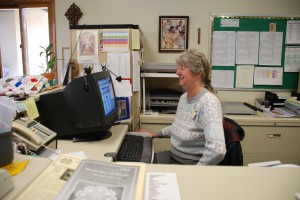Category Archives: Education
The “online, student engagement application that provides instant access to plug-and-play gamification tools (points, badges, and leaderboards) that incentivizes students to become more engaged in their school and their community. Youtopia grows with students from kindergarten to college.”
 The efficient management of the classroom can be impacted by a variety of factors. According to experts Edmund Emmer and Carolyn Evertson (authors of Classroom Management for Effective Teachers), these include: ensuring the students are involved in all classroom activities as much as possible; ensuring student behavior does not negatively impact the teacher’s/students’ work, and using instructional time efficiently.
The efficient management of the classroom can be impacted by a variety of factors. According to experts Edmund Emmer and Carolyn Evertson (authors of Classroom Management for Effective Teachers), these include: ensuring the students are involved in all classroom activities as much as possible; ensuring student behavior does not negatively impact the teacher’s/students’ work, and using instructional time efficiently.
Efficient classroom educators are very well-organized in their rules and schedules which they have passed over to their students. This involves effective communication of expectations to the students. In other words, the philosophy of Harry Wong: “A well-managed classroom is a task-oriented and predictable environment.”
What does this mean for the school and indeed the classroom? It means that everything is in its place: from the school chairs to the computers, the blackboard to where the classroom door is situated. In addition, when students are given clarification on teacher expectations and what will happen if these are not met, then it is more likely they will follow the rules and all aspects of the classroom will run smoothly.
According to a 1986 study by Marcel Veenman PhD, assistant professor in the unit Developmental and Educational Psychology of the Institute of Psychology at Leiden University, the most commonly reported problems from teachers in their first years are organization, classroom management and student discipline. Thus if this is dealt with ahead of time – by ensuring a classroom is well managed even before the students start to learn – a lot of the issues can be potentially avoided.
This quick video on how to organize classroom desks.
 The way a classroom is organized – from where the artwork is to how the classroom furniture is laid out – has been found to have an impact on how the children learn and how they behave. When administrators arrange the layout of the classroom, they need to remember that the students have to see and hear instructions clearly and be able to access the materials efficiently. The teacher should be in a place that he or she can easily monitor the students and provide feedback.
The way a classroom is organized – from where the artwork is to how the classroom furniture is laid out – has been found to have an impact on how the children learn and how they behave. When administrators arrange the layout of the classroom, they need to remember that the students have to see and hear instructions clearly and be able to access the materials efficiently. The teacher should be in a place that he or she can easily monitor the students and provide feedback.
Important elements to consider when organizing the classroom include: laying out the desks so that the attention is directed toward the teacher and making sure the students are facing the front of the classroom (and away from the windows). Furniture should be arranged so that the teachers can see all the students at all times. And, so that teachers can move among the school desks easily.
Classroom furniture should also be arranged so that there is access to where the artwork etc. is displayed. Student materials and teacher materials should be separated and students should b e able to quickly find their work.
These are just some ideas for developing and maintaining classroom efficiency and enhancing the likelihood of improved student behavior.
 The Classroom Organization and Management Program, otherwise referred to as COMP, came about following the research of Dr. Carolyn M. Evertson. The program has shown substantial benefit to both students and teachers through research conducted in 12 studies in both mainstream and special education resource settings from grades K to 12. This research was undertaken over 15 years, and observed 581 classrooms in 100 schools.
The Classroom Organization and Management Program, otherwise referred to as COMP, came about following the research of Dr. Carolyn M. Evertson. The program has shown substantial benefit to both students and teachers through research conducted in 12 studies in both mainstream and special education resource settings from grades K to 12. This research was undertaken over 15 years, and observed 581 classrooms in 100 schools.
COMP has been providing services to more than 100,000 administrators and teachers since its 1989 launch. During this time it has been shown that student behavior has improved as well as academic results. This naturally leads to an increase in teacher satisfaction.
Of course, it makes sense that if a classroom is organized efficiently there will be less chaos. If school desks are just laid out haphazardly, it is less likely to lead to the creation of a relaxed environment. With COMP, teachers, students and others involved in the educational process are given tips on making the classrooms more efficient.
This video discusses the concept of how to create a classroom organization that works for you and your student.
 The way a classroom is organized should reflect the educator’s teaching style as much as possible. The school furniture should be arranged in a way that makes it easier to teach in small groups, large groups, one-on-one or individuals, depending on how classes are taught. For those who use a lot of group discussions, the furniture should be arranged in a circle or U-shape. But those who prefer teaching students individually, learning stations should be laid out.
The way a classroom is organized should reflect the educator’s teaching style as much as possible. The school furniture should be arranged in a way that makes it easier to teach in small groups, large groups, one-on-one or individuals, depending on how classes are taught. For those who use a lot of group discussions, the furniture should be arranged in a circle or U-shape. But those who prefer teaching students individually, learning stations should be laid out.
The way the furniture in the class is organized should also reflect the teacher. Teachers should make sure their classrooms are personalized with selected children’s art, posters, and soft rugs, etc. One example of this is what was done in a classroom in Reggio Emilia. Early childhood programs feature children’s work. These are collections of objects they find. They are set out in large spaces to ensure little clutter in the room. The actual class environment is viewed as “another teacher,” and thus it is used to motivate children, improve their educational experience and limit any behavioral issues…just as a teacher might do.
Indeed, according to Mike Hopkins, an educator and author, one should think about the way a classroom is designed in connection with their personal teaching style. In this way, teachers should try to forget about the standard way classrooms are organized and get their ideas from museums, other classrooms, even TV shows, so long as it reflects their teaching style.
Check out this YouTube video on classroom organisation ideas for teachers through Ashley’s first video blog.
 Classroom organization is important for three main reasons: to maximize the opportunity for learning; minimize the occurrence of behavioral disorderly issues and establish a positive and safe environment for the students.
Classroom organization is important for three main reasons: to maximize the opportunity for learning; minimize the occurrence of behavioral disorderly issues and establish a positive and safe environment for the students.
To achieve these goals, one should consider the following. First, one should ensure that the children are sitting in a way that their focus is directed toward the teacher. Second, classroom chairs should be placed in a way that children can easily see chalkboards, screens, etc. Third, all children should be facing the front of the room, away from the windows. Fourth, the teacher should be able to see all children at all times – so their desks should be laid out accordingly.
Teachers should be able to move around the classroom with ease, so that they can monitor tasks being undertaken and behavior. There should be no blockage where teachers need to move around. Learning materials should be organized and available for teachers and children at the front of the room.
Student work should not just be displayed haphazardly; there should be a specially-delegated areas for this and children should be able to easily find and show off their work when parents come in. For both children and teachers there should be easy access to materials that are often used.
By following these simple rules, the process of achieving the three above-mentioned goals is facilitated.
When it comes to classroom organization and general management at school, there are three main mistakes teachers make:





